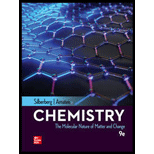
(a)
Interpretation:
The carbon (graphite) is a conductor; semiconductor or insulator is to be determined.
Concept introduction:
Band theory is a model that defines the energy of the electrons in the solid and determines the conductivity of the solids. It is derived from the theory of the molecular orbital. The lower occupied molecular orbital is known as valence band and higher unoccupied molecular orbital are known as the conduction band. The solids can be classified on the basis of band theory as follows:
1. Conductors.
2. Semiconductor
3. Insulators
A periodic table is an arrangement of elements based on their
(b)
The sulfur is a conductor; semiconductor or insulator is to be determined.
Concept introduction:
Band theory is a model that defines the energy of the electrons in the solid and determines the conductivity of the solids. It is derived from the theory of the molecular orbital. The lower occupied molecular orbital is known as valence band and higher unoccupied molecular orbital are known as the conduction band. The solids can be classified on the basis of band theory as follows:
1. Conductors.
2. Semiconductor
3. Insulators
A periodic table is an arrangement of elements based on their atomic number, properties, and electronic configuration. The table is arranged into groups and periods. The elements which are metallic in nature, occupy the large lower-left portion of the table. The non-metals occupy the small upper-right portion of the table. Metalloids like along the staircase line. Elements which appear in the same group have similar behavior.
(c)
The platinum is a conductor; semiconductor or insulator is to be determined.
Concept introduction:
Band theory is a model that defines the energy of the electrons in the solid and determines the conductivity of the solids. It is derived from the theory of the molecular orbital. The lower occupied molecular orbital is known as valence band and higher unoccupied molecular orbital are known as the conduction band. The solids can be classified on the basis of band theory as follows:
1. Conductors.
2. Semiconductor
3. Insulators
A periodic table is an arrangement of elements based on their atomic number, properties, and electronic configuration. The table is arranged into groups and periods. The elements which are metallic in nature, occupy the large lower-left portion of the table. The non-metals occupy the small upper-right portion of the table. Metalloids like along the staircase line. Elements which appear in the same group have similar behavior.
Want to see the full answer?
Check out a sample textbook solution
Chapter 12 Solutions
Chemistry: The Molecular Nature of Matter and Change
- How does the square root mean square velocity of gas molecules vary with temperature? Illustrate this relationship by plotting the square root mean square velocity of N2 molecules as a function of temperature from T=100 K to T=300 K.arrow_forwardDraw product B, indicating what type of reaction occurs. F3C CF3 NH2 Me O .N. + B OMearrow_forwardBenzimidazole E. State its formula. sState the differences in the formula with other benzimidazoles.arrow_forward
- Draw product A, indicating what type of reaction occurs. F3C CN CF3 K2CO3, DMSO, H₂O2 Aarrow_forward19) Which metal is most commonly used in galvanization to protect steel structures from oxidation? Lead a. b. Tin C. Nickel d. Zinc 20) The following molecule is an example of a: R₁ R2- -N-R3 a. Secondary amine b. Secondary amide c. Tertiary amine d. Tertiary amidearrow_forwardpls helparrow_forward
- pls helparrow_forward35) Complete the following equation by drawing the line the structure of the products that are formed. Please note that in some cases more than one product is possible. You must draw all possible products to recive full marks! a. ethanol + 2-propanol + H2SO4 → b. OH conc. H2SO4 CH2 H3C CH + K2Cr2O7 C. d. H3C A pressure CH3 + H2 CH Pt catalystarrow_forward21) The rate of reaction depends upon: a. the concentration and nature of reactants b. the temperature of the reaction C. whether or not a catalyst was used d. all of the above 22) A Maxwell-Boltzmann curve shows the distribution of molecular energies in a reaction system. When the temperature in this system is increased, the peak is a. higher and further to the right. b. higher and further to the left. c. lower and further to the right. d. lower and further to the left. 23) Which of the following correctly describes the reaction represented by the reaction below? CaCO3 (s) + energy → CaO (s) + CO2 (g) a. It is exothermic and the potential energy is greater in the reactants than the products. b. c. It is exothermic and the potential energy is greater in the products than the reactants. It is endothermic and the potential energy is greater in the products than the reactants. d. It is endothermic and the potential energy is equal for the products and reactants.arrow_forward
 ChemistryChemistryISBN:9781305957404Author:Steven S. Zumdahl, Susan A. Zumdahl, Donald J. DeCostePublisher:Cengage Learning
ChemistryChemistryISBN:9781305957404Author:Steven S. Zumdahl, Susan A. Zumdahl, Donald J. DeCostePublisher:Cengage Learning ChemistryChemistryISBN:9781259911156Author:Raymond Chang Dr., Jason Overby ProfessorPublisher:McGraw-Hill Education
ChemistryChemistryISBN:9781259911156Author:Raymond Chang Dr., Jason Overby ProfessorPublisher:McGraw-Hill Education Principles of Instrumental AnalysisChemistryISBN:9781305577213Author:Douglas A. Skoog, F. James Holler, Stanley R. CrouchPublisher:Cengage Learning
Principles of Instrumental AnalysisChemistryISBN:9781305577213Author:Douglas A. Skoog, F. James Holler, Stanley R. CrouchPublisher:Cengage Learning Organic ChemistryChemistryISBN:9780078021558Author:Janice Gorzynski Smith Dr.Publisher:McGraw-Hill Education
Organic ChemistryChemistryISBN:9780078021558Author:Janice Gorzynski Smith Dr.Publisher:McGraw-Hill Education Chemistry: Principles and ReactionsChemistryISBN:9781305079373Author:William L. Masterton, Cecile N. HurleyPublisher:Cengage Learning
Chemistry: Principles and ReactionsChemistryISBN:9781305079373Author:William L. Masterton, Cecile N. HurleyPublisher:Cengage Learning Elementary Principles of Chemical Processes, Bind...ChemistryISBN:9781118431221Author:Richard M. Felder, Ronald W. Rousseau, Lisa G. BullardPublisher:WILEY
Elementary Principles of Chemical Processes, Bind...ChemistryISBN:9781118431221Author:Richard M. Felder, Ronald W. Rousseau, Lisa G. BullardPublisher:WILEY





